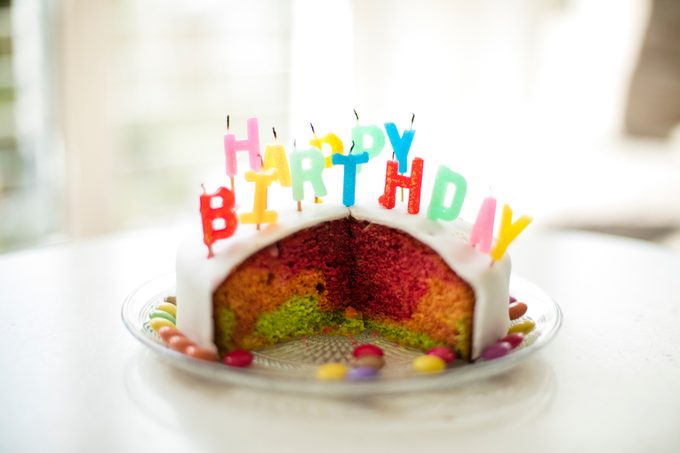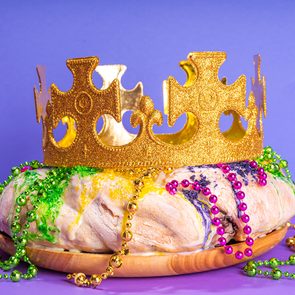Hint: The origin of birthday cakes has to do with the ancient Egyptians and Greeks!

Here’s the Real Origin of Birthday Cakes

White, marble, chocolate, red velvet, devil’s food, ice cream and more—there are hundreds of types of birthday cake in the world, each beautiful in its own sugary way. Odds are, you have a slice (or two) each year on your birthday. But in between those delicious bites, have you ever stopped and wondered about the origin of birthday cakes?
We could say that your birthday cake is proof that you’re as important and beloved as the gods. Well, kind of. If that sounds like a stretch, read on to learn about the origin of birthday cakes and how they’ve evolved from an ancient tradition to a modern must-have. Then light those candles, ready the birthday song and prepare to dig in.
Get Reader’s Digest’s Read Up newsletter for more knowledge, tech, travel, cleaning, humor and fun facts all week long.
What is the origin of birthday cake?
Understanding the origin of birthday cakes goes beyond just finding out who invented cake. From ancient rituals to modern-day sugar rushes, there’s a delicious history behind how these sweet treats became a part of birthdays. Ahead, you’ll find out how it came to be.
The first birthday celebration
The ancient Egyptians are credited with “inventing” the celebration of birthdays. They believed that when pharaohs were crowned, they became gods, so their coronation day was a pretty big deal—essentially their “birth” as gods. But there was no birthday cake at the scene just yet.
The first birthday cake and candles
Ancient Greeks borrowed the tradition but rightfully realized that a dessert would make the celebration all the more meaningful. (And we agree!) So they baked moon-shaped cakes to offer up to Artemis, goddess of the moon, as a tribute. They decorated them with lit candles to make the cakes shine like the moon. And that’s why we put candles on our birthday cakes.
However, the birthday cakes featured in ancient Greek birthdays were quite different from the ones we cut today.
How have birthday cakes evolved over time?
Birthday cakes haven’t always looked like the frosted, sprinkle-covered confections we know today. Everything from their shape and size to the ingredients used has evolved over time.
Here’s how they transformed through the centuries. Hint: Even the Industrial Revolution had a hand in the batter.
Birthday cakes until the 18th century
Modern birthday parties are said to have their roots in the 18th-century German celebration called Kinderfeste. On the morning of a child’s birthday, he or she would receive a cake with lit candles that added up to the kid’s age plus one. This extra candle was called the “light of life,” representing the hope of another full year lived.
And then came the torture: No one could eat the cake until after dinner. The family replaced the candles as they burned out throughout the day. Finally, when the moment came, the child would make a birthday wish, try to blow out all the candles in one breath and dig in. And of course, just like modern tradition, the birthday girl or boy wouldn’t tell anyone the wish so that it would come true.
Birthday cakes after the Industrial Revolution
Until the Industrial Revolution, birthday cakes were a luxury—quite literally. With ingredients like sugar, butter and refined flour being costly, only the wealthy could afford to celebrate with a sweet slice. (Fun fact: According to historian Elizabeth Pleck, even wealthy Americans didn’t really throw birthday parties until the 1830s. So a birthday cake wasn’t always a given.)
During the Industrial Revolution, everything changed. Mass production made baking staples cheaper and more accessible, and bakeries began selling ready-made cakes. Suddenly, the once exclusive treat became a festive must-have for all, showing up not just on birthdays but on any occasion as an excuse to gather and indulge.
The bottom line
The origin of birthday cake is layered (pun very much intended). From ancient offerings to mass-produced treats, the birthday cake has journeyed through centuries, cultures and customs to earn its spot at the center of joyous celebrations. While today’s birthday cakes might be covered in rainbow sprinkles and alight with candles, it’s worth acknowledging the trip the tradition took to get to your table.
Why trust us
At Reader’s Digest, we’re committed to producing high-quality content by writers with expertise and experience in their field in consultation with relevant, qualified experts. We rely on reputable primary sources, including government and professional organizations and academic institutions as well as our writers’ personal experiences where appropriate. We verify all facts and data, back them with credible sourcing and revisit them over time to ensure they remain accurate and up to date. Read more about our team, our contributors and our editorial policies.
Sources:
- Historical Bookworm: “Birthday Traditions”
- Food & Wine: “A Brief History of the Birthday Cake”























